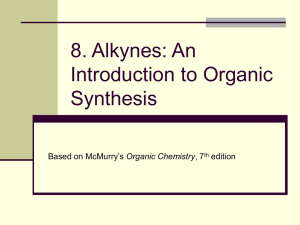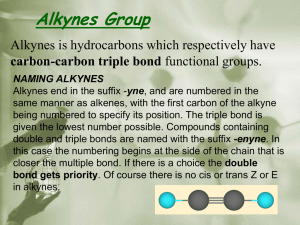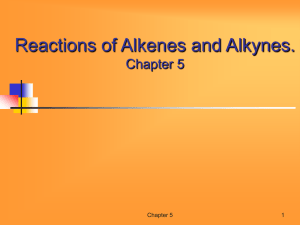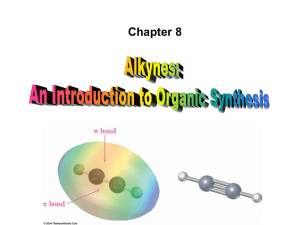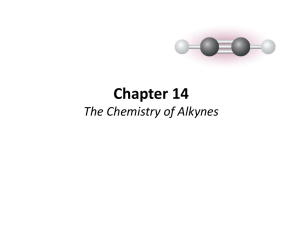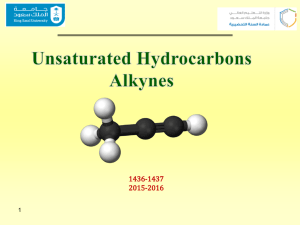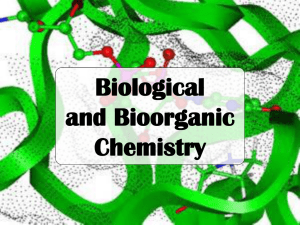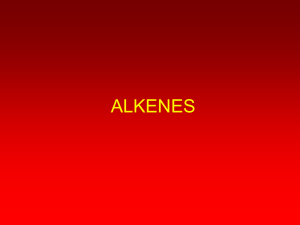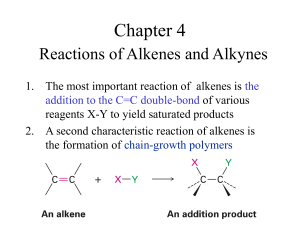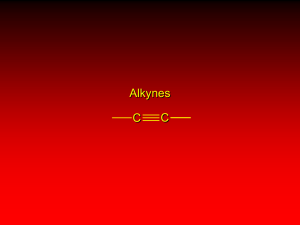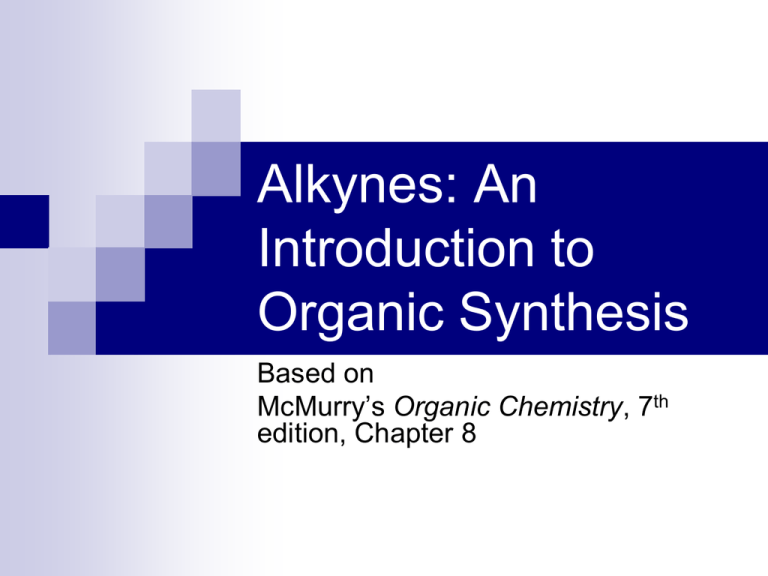
Alkynes: An
Introduction to
Organic Synthesis
Based on
McMurry’s Organic Chemistry, 7th
edition, Chapter 8
Alkynes
Hydrocarbons that contain carbon-carbon
triple bonds
Our study of alkynes provides an
introduction to organic synthesis, the
preparation of organic molecules from
simpler organic molecules
2
Alkynes
Acetylene, the simplest alkyne, is produced
industrially from methane and steam at
high temperature
3
8.1 Naming Alkynes
General hydrocarbon rules apply with “yne” as a suffix
indicating an alkyne
Numbering of chain with triple bond is set so that the
smallest number possible includes the triple bond
4
Diynes, Enynes, and Triynes
A compound with two triple bonds is a
diyne
An
enyne has a double bond and triple bond
A triyne has three triple bonds
Number from chain that ends nearest a
double or triple bond – double bonds are
preferred if both are present in the same
relative position
5
Diynes, Enynes, and Triynes
6
Problem 8.1: IUPAC names?
7
8.2 Preparation of Alkynes: Elimination
Reactions of Dihalides
Treatment of a 1,2 dihaloalkane with KOH or NaOH
produces a two-fold elimination of HX
Vicinal dihalides are available from addition of bromine or
chlorine to an alkene
8
8.2 Preparation of Alkynes: Elimination
Reactions of Dihalides
Intermediate is a vinyl halide
9
8.3 Reactions of Alkynes: Addition
of HX and X2
Addition
reactions of alkynes are
similar to those of alkenes
Intermediate alkene reacts further
with excess reagent
Regiospecificity according to
Markovnikov
10
Electronic Structure of Alkynes
The triple bond is shorter and stronger than
single or double
Breaking a π bond in acetylene (HCCH) requires
318 kJ/mole (in ethylene it is 268 kJ/mole)
11
8.4 Reactions of Alkynes:
Addition of HX and X2
12
Addition of Bromine and
Chlorine
Initial addition gives trans intermediate
Product with excess reagent is tetrahalide
13
Addition of HX to Alkynes Involves
Vinylic Carbocations
Addition of H-X to alkyne should produce a vinylic
carbocation intermediate
Secondary vinyl carbocations form less readily than
primary alkyl carbocations
Primary vinyl carbocations probably do not form at all
14
Vinylic carbocations
15
8.4 Hydration of Alkynes
Addition of H-OH as in alkenes
Mercury (II) catalyzes Markovinikov oriented addition
Hydroboration-oxidation gives the non-Markovnikov product
16
Mercury(II)-Catalyzed Hydration of
Alkynes
Mercuric ion (as the sulfate) is a Lewis acid catalyst
that promotes addition of water in Markovnikov
orientation
The immediate product is a vinylic alcohol, or enol,
which spontaneously transforms to a ketone
17
Keto-enol Tautomerism
Isomeric compounds that can rapidily
interconvert by the movement of a proton are
called tautomers and the phenomenon is
called tautomerism
Enols rearrange to the isomeric ketone by the
rapid transfer of a proton from the hydroxyl to
the alkene carbon
The keto form is usually so stable compared
to the enol that only the keto form can be
observed
18
Keto-enol Tautomerism
19
Hydration of Unsymmetrical
Alkynes
If the alkyl groups at either end of the C-C triple bond
are not the same, both products can form.
Hydration of a terminal always gives the methyl ketone
20
21
Hydroboration/Oxidation of Alkynes
BH3 (borane) adds to alkynes to give a vinylic borane
Oxidation with H2O2 produces an enol that converts to
the ketone or aldehyde: anti-Markovnikov
22
Comparison of Hydration of
Terminal Alkynes
Hydroboration/oxidation converts terminal alkynes to
aldehydes because addition of water is non-Markovnikov
23
8.5 Reduction of Alkynes
Addition of H2 over a metal catalyst (such as
palladium on carbon, Pd/C) converts alkynes to
alkanes (complete reduction)
The addition of the first equivalent of H2
produces an alkene, which is more reactive than
the alkyne so the alkene is not observed
24
Incomplete reduction: Conversion
of Alkynes to cis-Alkenes
Addition of H2 using chemically deactivated palladium
on calcium carbonate as a catalyst (the Lindlar
catalyst) produces a cis alkene
The two hydrogens add syn (from the same side of
the triple bond)
25
7-cis-Retinol synthesis
(Hoffmann-LaRoche):
26
Incomplete reduction: Conversion
of Alkynes to trans-Alkenes
Anhydrous ammonia (NH3) is a liquid below -33 ºC
Alkali metals dissolve in liquid ammonia and function as reducing
agents
Alkynes are reduced to trans alkenes with sodium or
lithium in liquid ammonia
27
28
8.7 Alkyne Acidity: Formation of
Acetylide Anions
Terminal alkynes are weak Brønsted acids (pKa ~ 25).
Reaction of strong anhydrous bases with a terminal
acetylene produces an acetylide ion
The sp-hydbridization at carbon holds negative charge
relatively close to the positive nucleus, stabilizing the
anion.
29
Note: pKa of NH3 is 33
30
31
8.8 Alkylation of Acetylide Anions
Acetylide
ions can react as
nucleophiles as well as bases
32
33
8.8 Alkylation of Acetylide
Anions
Reaction with a primary alkyl halide produces a
hydrocarbon that contains carbons from both partners,
providing a general route to larger alkynes
34
Limitations of Alkyation of Acetylide
Ions
Reactions only are efficient with 1º alkyl bromides and
alkyl iodides
Reactions with 2º and 3º alkyl halides gives
dehydrohalogenation, converting alkyl halide to alkene
35
Prob. 8.11: Which alkyne/alkyl halide
combination would work?
36
8.9 An Introduction to Organic
Synthesis
Organic synthesis creates molecules by design
Synthesis can produce new molecules that are
needed as drugs or materials
Syntheses can be designed and tested to
improve the efficiency and safety of making
known molecules
Highly advanced syntheses are used to test
ideas and methods, confirm structures, and
demonstrate methods
37
Synthesis as a Tool for Learning
Organic Chemistry
In order to propose a synthesis you must
be familiar with reactions
What
they begin with
What they lead to
How they are accomplished
What the limitations are
38
Synthesis as a Tool for Learning
Organic Chemistry
A
synthesis combines a series of
proposed steps to go from a defined
set of reactants to a specified product
Questions
related to synthesis can
include partial information about a
reaction of series that the student
completes (“roadmap” problem)
39
Strategies for Synthesis
Compare the target and the starting
material
Consider reactions that efficiently produce
the outcome. Look at the product and
think of what can lead to it (retrosynthetic
method)
Example
Problem:
Strategy:
prepare octane from 1-pentyne
use acetylide coupling
40
Practice Prob. 8.1
41
Practice Prob 8.2:
42
Last step in the synthesis:
43
Making 2-hexyne:
44
Putting it together:
45
Prob. 8.37: Synthesize from
acetylene
46
Prob. 8.40: Synthesize muscalure
(house fly sex attractant)
H
H
muscalure
Z-9-tricosene
47

